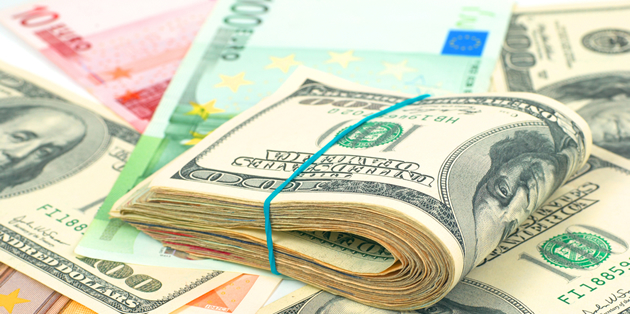Optimism has proven short-lived for the Pound this week, leaving the Pound to Euro exchange rate on a weaker footing as worries over the outlook of the UK economy remained heightened.
- Pound struggled to maintain gains made on Brexit debate relief rally – Hard line of government ministers continued to worry markets
- Euro trended higher as ECB seen to be less likely to ease – Single currency shored up by steady final German CPI data
- Fed meeting minutes encouraged higher odds of December rate hike – US Dollar nevertheless failed to make strong gains
- GBP EUR exchange rate forecast to strengthen on narrowed Eurozone trade surplus – Weaker data could dent Euro demand
Weak US Price Data Boosted GBP USD Exchange Rate Further
The GBP USD exchange rate was encouraged to trend higher in response to disappointing US Import Price Index data. Investors were not impressed to find that price growth had fallen short of forecast on both the month and the year in September, undermining the impression of the US economy’s robustness. As a result the GBP USD exchange rate was making strong gains in the region of 1.22 towards the close of the European session.
The GBP EUR exchange rate, meanwhile, remained on a narrow trend around 1.10.
(Previously updated at 14:39 13/10/16)
Although the Fed’s September meeting minutes showed greater leanings amongst policymakers towards an interest rate hike this was not enough to see the GBP USD exchange rate slump further.
GBP Exchange Rates Remained Volatile as Brexit Uncertainty Continued to Cloud Economic Outlook
Despite experiencing a boost on the back of the government’s U-turn on allowing a debate on the terms of Brexit it wasn’t long before the Pound (GBP) returned to a weaker footing. Markets remain distinctly concerned by the harder line of rhetoric being taken by government ministers and the prospect of the UK losing access to the single market. Anxiety was also stirred up by the news that Tesco and major brand supplied Unilever are engaging in a standoff over a proposed 10% increase in wholesale prices. All in all, the outlook of the domestic economy remains far from clear, leaving GBP exchange rates softer.
The Pound could find a temporary rallying point on Friday’s UK construction output figures, assuming that the data points towards resilience. Following July’s sharp slump investors are expecting to see a solid rebound in sector output, something that could suggest that the economy recovered well from the initial volatility of the referendum result. Even so, given that Sterling has been increasingly divorced from positive domestic data recently the impact of a strong showing could prove somewhat limited.
Euro (EUR) Demand Forecast to Weaken on Narrowed Eurozone Trade Surplus
September’s finalised German Consumer Price Index offered no surprise to investors, being unchanged from the provisional result. This indicated that inflation within the Eurozone’s powerhouse economy remains on an uptrend, albeit still a long way shy of policymakers’ target range. As a result the Euro (EUR) was encouraged to regain ground against the Pound, particularly with markets speculating that the European Central Bank (ECB) could be looking to move away from monetary loosening.
Confidence in the single currency is likely to remain weak, however, given the increased appeal of the US Dollar (USD). The Pound to Euro (GBP EUR) exchange rate could also benefit from the Eurozone’s August trade balance, which is expected to show a narrowing of the trade surplus from 25.3 billion to 15.3 billion. Should the currency union demonstrate signs of weakness then the Euro could come under increased pressure ahead of the weekend.
GBP USD Trending Narrowly Despite Fed Meeting Minutes Raising Odds of December Rate Hike
Demand for the ‘Greenback’ was boosted by the Federal Reserve’s September meeting minutes, which were seen to increase the likelihood of the central bank raising interest rates before the end of the year. As Philip Marey, Senior US Strategist at Rabobank, noted:
‘In fact, it was noted that a reasonable argument could be made either for an increase at this meeting or for waiting for some additional information on the labour market and inflation. Among the participants who supported awaiting further evidence of continued progress toward the Committee’s objectives, several stated that the decision at this meeting was a close call.’
However, as recent US data has proven to be somewhat mixed and markets have already priced in relatively high odds of a December rate hike this failed to extend the downtrend of the Pound to US Dollar (GBP USD) exchange rate further.
There will be a number of high impact events for the US Dollar on Friday, though, which could see the GBP USD exchange rate pushed back towards multi-year lows. Both the September Advance Retail Sales figure and October University of Michigan Confidence Index are expected to show improvement on the month. If these prove encouraging and Fed Chair Janet Yellen adopts a more hawkish tone in comments at the Boston Fed Conference then the ‘Greenback’ could return to its more bullish form.
Current Interbank Exchange Rates
At the time of writing, the Pound to Euro (GBP EUR) exchange rate was on a downtrend at 1.10, while the Pound to US Dollar (GBP USD) pairing was trending narrowly in the region of 1.21.



